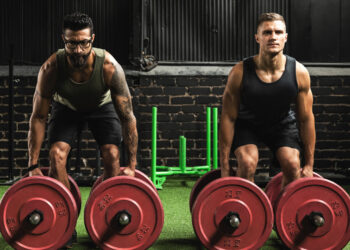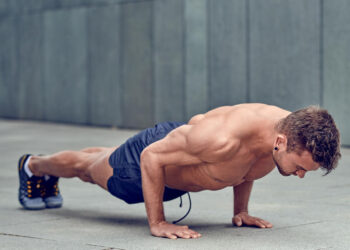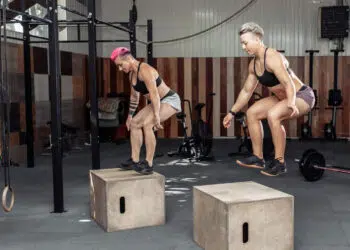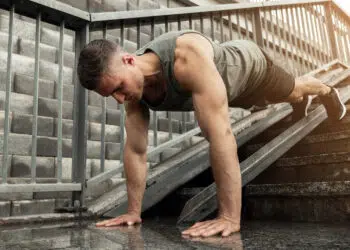Frog hops aren’t an exercise you do to bring out your inner amphibian (although no one is stopping you). Rather, it’s another useful lower body bodyweight exercise that can build and strengthen your lower body, help you to burn more calories and drop pounds, and improve your overall fitness.
This plyometric activity is ideal for those who can handle a little impact on the joints as it does involve hopping but nothing crazy, so most people who are a healthy weight with healthy joints should benefit from it.
In this guide, we’ve explained how to do it with tips, variations, and more.
Muscles Worked
Frog hops, when done safely, work the lower body muscles. Here are short descriptions of each one.
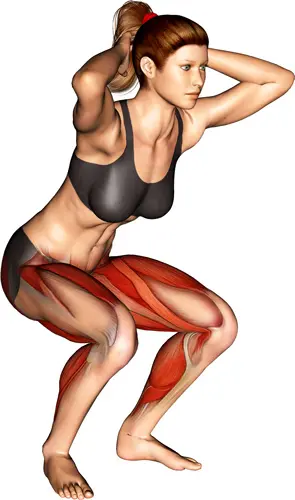
Quadriceps – Being an athletic focused exercise, the leg muscles should be the target muscle group, especially the powerful quads between the knee and hips on the front part of your thigh formed by five muscles. The quadriceps are activated when you dip down into a squat and extend the knee to stand straight or leap vertically.
Hamstrings – Squats and hops are a great total thigh exercise which means it’ll work the quads as well as the hamstrings muscles. Boasting three heads, the hamstring muscles – biceps femoris, semimembranosus, and semitendinosus. An injury prone muscle, hamstrings have to flex the knee and extend the hips when we do daily activities.
Level Up Your Fitness: Join our 💪 strong community in Fitness Volt Newsletter. Get daily inspiration, expert-backed workouts, nutrition tips, the latest in strength sports, and the support you need to reach your goals. Subscribe for free!
Glutes – Gluteus maximus, medius and minimus are the muscles that form the shape and appearance of our hips and rear end. Although the gluteus tends to get the spotlight being the largest and most powerful of the three. Maximus executes extension and external rotation of the thigh, and support of the trunk and pelvis.
Core – A strong core will make you stronger and better at almost everything. The abdominal muscles help us to create a solid midsection to maximize lower body strength and posture.
How To Do Frog Hops
It’s quite a simple exercise, but here are step-by-step instructions for performing frog hops.
- Place your hands behind your head but do not pull down on your neck.
- Squat down until your upper legs are about parallel to the ground while keeping a straight back.
- Hop several feet forward and land softly on your toes or midfoot while absorbing the impact by bending your knees as you return to the starting squat position.
- Continue to hop forward for the desired number of reps.
Here’s a video example of frog hops…
Frog hops tips
- Jump softly to minimize the impact on your joints.
- Avoid landing on your heels as this is not ideal for knee health.
- To make this a more explosive movement, you can use more force during your hops to jump higher and farther. Although, we recommend low to medium reps as this variation is higher impact on the joints.
3 Variations/Alternatives
While frog hops is a useful activity that you can do anywhere to train your lower body and athleticism, here are three variations/alternatives we recommend to keep things interesting and give you a more rounded workout.
Frog squat
The frog squat is another lower body builder with the name frog in it. This movement is one of the more unique ones but make no mistake, it’s a viable bodyweight option that you can use to build your leg muscles.
Box jumps
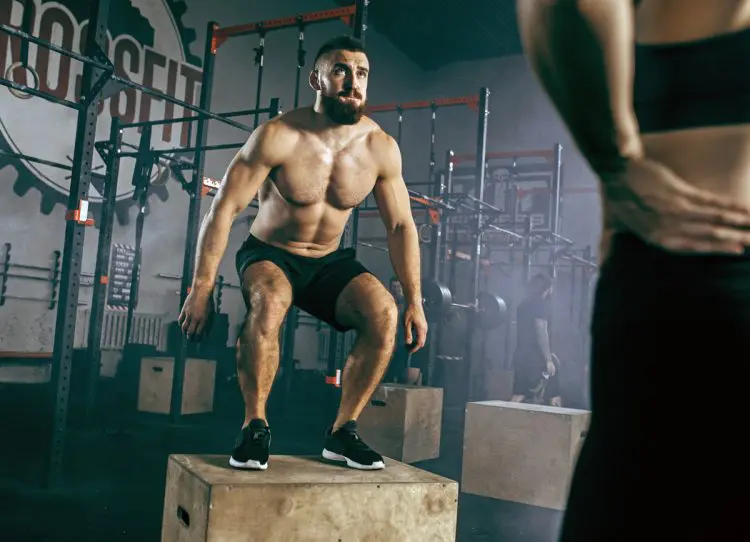
Box jumps are an excellent exercise that improves explosive power and strength and builds your leg muscles possibly better than frog hops. Not to mention, it’s a great calorie-burner to help you get leaner.
It’s an activity that many athletes perform to develop and enhance their athleticism and when done right, isn’t bad for your joints.
You can use any size box however, we recommend working up to a decent height box to really challenge yourself and reap the benefits.
Level Up Your Fitness: Join our 💪 strong community in Fitness Volt Newsletter. Get daily inspiration, expert-backed workouts, nutrition tips, the latest in strength sports, and the support you need to reach your goals. Subscribe for free!
Box Jump Exercise Guide – Muscles Worked, How-to, Tips, and Variations
Basic bodyweight squat
Of course, if you just want to work your leg muscles and aren’t able to do hops, the basic bodyweight squat is always a good choice.
Place your feet slightly wider than shoulder-width keeping your toes pointed slightly outward. While keeping your back straight, simply squat down to parallel or just below and push through your feet back into the standing position.
To make this exercise more challenging, hold two weights down by your sides or hold a kettlebell at your chest to perform the effective goblet squat variation.
Also read: The 12 Best Squat Variations for Hypertrophy and Strength
How To Incorporate Frog Hops Into Your Training Regime
There’s no rocket science here… frog hops are just another lower body exercise option that you can include in your training via many different ways.
For example, you may not have access to weight or any resistance training tool. Therefore, frog hops make for a great exercise that only requires your body weight.
Or maybe you want to finish off your workout with a simple, easy-to-do plyometric activity that’ll help you to be more well-rounded and fit.
You could also include frog hops in a workout circuit as part of a cardio fitness routine. There are so many different options.
Related: Circuit Training: The Ultimate Guide
Sets and reps
This depends on how you use the exercise which we’ve previously touched on. There’s no ideal number of sets and reps however, a common method would be to do 3-4 sets of 10-20 reps.
You could set a predetermined distance, hop until you reach the set mark, and then hop back to the starting point. Or take a few hops and return to the starting position.
Wrapping Up
Frog hops can make for a useful lower body exercise option that you use to build and strengthen your body from the torso down. Plus, it’s a good calorie-burner, and may also help to enhance your athleticism and improve joint mobility and flexibility.
Interested in measuring your progress? Check out our strength standards for Bodyweight Squat, Goblet Squat, Squat.




